Learning 'Poco a Poco' in Honduras
Learning 'Poco a Poco' in Honduras
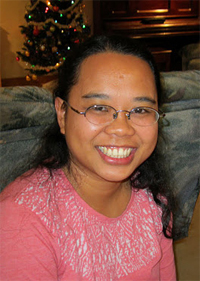
By Mary Ann Ofialda
The author, from Iloilo City, is working as a lay missionary in Honduras with the PME Fathers. She worked as a Columban Lay Missionary from August 2003 to April 2006 in Taiwan. In July 2012 she was assigned to Tegucigalpa, the capital of Honduras. Currently, she is working as a volunteer at a home for the aged, Hogar de Ancianos Maria Eugenia, and in Casa Ángeles, a home for abandoned/orphaned children with severe physical and mental disabilities, and the mission animation project, Ad Gentes. Mary Ann worked in Taiwan as a Columban Lay Missionary from August 2003 to April 2006.

The author, center, with children in Honduras.
‘One doesn't discover new lands without consenting to lose sight, for a very long time, of the shore.’– André Gide.
In 2011, when I was accepted into the second level formation in Davao del Sur of the Société des Missions-Étrangères or the Foreign Mission Society of Quebec, known in the Philippines as the PME Fathers, I felt that I had taken a very significant step, venturing out to a unique kind of calling. It was a decision that took a lot of personal discernment, reflection, gradual detachment from my comfort zones as well as support and counsel from my family and close friends. My four months' experience during formation among the B’laan people in the mountains of Little Baguio, Davao del Sur, was a memorable story in itself.
The final formation in Centre International De Formation Missionnaire (CIFM) in Montreal, Quebec, continued the process of purifying my motivation. More and more the call to choose the life of a lay missionary associated with the PME Fathers had grown deeper. In every step of the way, I realized that to discern your vocation your life needs to be consistently re-examined and re-read. That is a never-ending process.
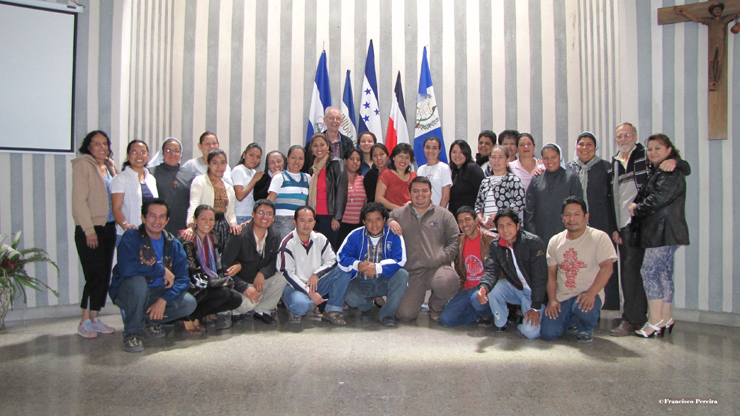
The author, second from left, standing, with other PME
lay missionaries.
During formation and discernment I also had to prepare myself for the next stage, being assigned for my first term of mission in a new country. I included my preference for any of the Spanish-speaking countries in Latin America when I wrote my application letter to the Central Council. Lay missionary candidates are allowed to name their country of preference but the Central Council of the Society makes the decision about the country of assignment.
When I received the news of my assignment to Honduras, Central America, I was pleased that my request had been granted. My first term contract was for four years. I did some research on Honduras on the internet but seemed to find more negative than positive reports about it. So as not to dampen my enthusiasm I stopped reading this discouraging information but somehow, I also couldn’t help but feel apprehensive, wondering what kind of life would be waiting for me there. I truly appreciated it when some of the retired Fathers in our central house would share their mission stories. Those who had lived in Honduras for many years recounted encouraging stories about their experience there.
I also took great comfort from my favourite Bible passages that over the years have never failed to offer refuge and strength on my missionary journey, especially Psalms 91 and 139.With these in my heart, I just had to trust in God’s providence, that He would take care of me in Honduras. After the mission-sending Mass and the signing of the contract, I had to say my goodbyes to some wonderful people I had met and befriended in Canada and was mentally and spiritually preparing myself for the journey ahead. I had mixed feelings of anxiety and wonder, anxiety at venturing out again into a new environment but wonder too at what lay ahead for me.
The night I arrived I got a general view of Tegucigalpa, the capital, from way up in the sky. Looking down at all the lights surrounding the city, it seemed to me at that time very mysterious and secretive. I received a warm welcome at the airport from priests and some of the lay missionaries. I temporarily stayed with the mission team in an area called Pantanal and they helped me get acquainted with the place, the food and the transportation, among other basic things. I got to meet the other members of the SME community in Honduras at our gatherings every Monday at the central house in the parish of Our Lady of Guadalupe. The SME Fathers are known here as ‘Padres Javerianos’ because of the Society’s patron, St Francis Xavier. It was also a gradual introduction for me to the different ways people were speaking Spanish. I was quite happy that some basic words are the same as in the Philippines, like cuchara, cuchillo, cubiertos, plato, la mesa, etc. Well, my happiness ended there and simple things got more complicated as I started studying Spanish.

The author.
My first integration in Honduras was to learn the language. Over the course of four months, I studied in a pleasant and secure place forty-five minutes away from the city called Valle de Ángeles, aptly translated as ‘Valley of the Angels’, in a school founded by a retired SME priest. As part of the language program, students have to stay with a family for the duration of their studies. I had the experience of living with two Honduran families from very different backgrounds and status in life. Both were very helpful in acquainting me with Spanish and practicing it.
In between language study I slowly familiarized myself with the different SME mission teams. As part of integration in the communities, small ‘insertion’ groups are formed with three or more members – women and men lay missionaries and priests coming from different cultural backgrounds – living together and belonging to the same mission team. Aside from the team in Pantanal, there is the team in Cerro Grande that focuses more on mission animation.
I currently belong to the team in Pantanal with a Canadian SME priest and a lay missionary from Colombia. After I finished studying Spanish I started to collaborate with the mission animation project and helping a team of volunteers at the diocesan level of formation. On the first Saturday of each month, a series of one-day sessions is held with persons who are willing and interested in going deeper as they discern about being lay missionaries Ad Gentes, ‘To the Nations’.
Another thing I am also in the stage of familiarizing myself with and helping out a little is the apostolate for children, Pastoral de la Niñez. The main recipients are mostly mothers and their young children. Various activities are planned every year by the leaders themselves. I help with the children’s tutorial class every Sunday morning in one of the interior colonias (zones). Poverty is very evident in all of Honduras and in Pantanal it is particularly apparent. The colonias are heavily populated, with limited access to basic necessities and sanitation. Scarcity is a way of life and most people are unemployed. These scenarios create many problems such as crimes and violence, generally drug-related. Gangs control the ever growing drug trade. This establishes an atmosphere of insecurity, distrust, and fear within the community. It is lamentable that the children in these colonias grow up in this kind of atmosphere.
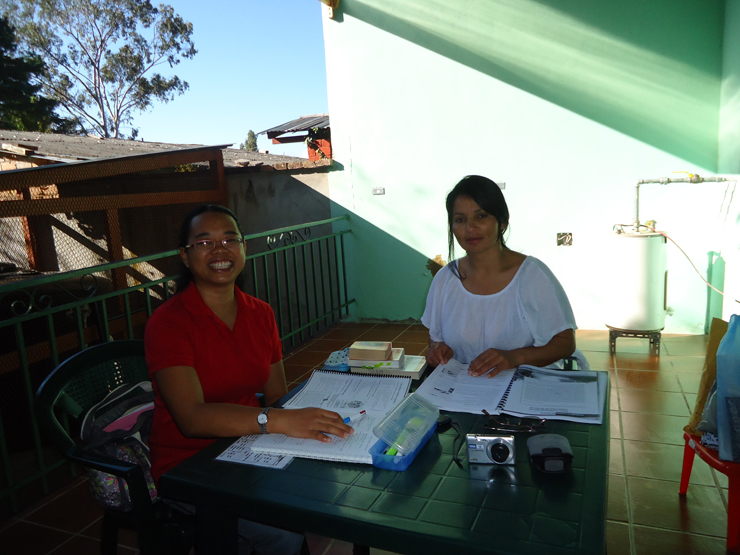
Preparing the next activity.
In rural villages, like in Valle de Ángeles, I still see a measure of hope. During Holy Week I experienced another face of Honduras that is totally in contrast to the dismal situation in urban areas. For a week in a rural village called Jalisco we were received with genuine hospitality, friendship and such positive community spirit. The families took turns in preparing our meals and offered us coffee and biscuits when we visited. The celebration of the Word was well-attended and participated in. They may be ordinary people living very simple lives but their spirituality is richly manifested through their kindness and generosity to strangers like us. There are other reasons to be optimistic such as the zeal of the young people. One thing very evident here is churches filled with young children, teens, all kinds of people from different walks of life breathing in freshness and dynamism at celebrations of Mass.
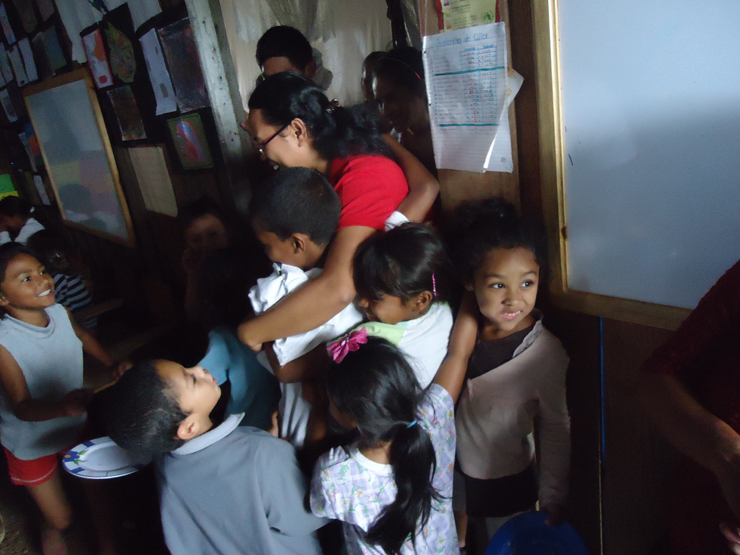
Mary Ann with children.
Nearly two years have passed since I arrived in Honduras. As people say to me in Spanish, everything is learned ‘poco a poco’ – little by little! I really believe this to be true especially when at times I feel out of my depth trying to adapt to the new environment, discovering new ways of living in a multi-cultural group, trying to get comfortable when speaking a new language, but also, recognizing and appreciating that sense of belonging as a new member.
I am under no illusions that this is a path that is easy to take, with its various challenges and uncertainties. But it has brought richness to my life through sharing and dialogue with various individuals and groups I have met along the way. I am really grateful that He has carried me this far.
Lastly, I pray that the presence of each missionary in mission areas all over the world may constantly be a source of blessing and a testimony of hope to others, since we are all pilgrims on the same path with God as our ultimate destination.
You may email the author at anjiao_2577@yahoo.com

Honduras
Honduras has a land area of 112,492 square kilometers, slightly larger than that of Luzon (109,985 sq kms). It has a population of more than 8 million, compared to Luzon’s of approximately 48 million (both 2010 estimates). As in the Philippines, about 80 percent are Catholics. The Catholic Church has one archdiocese and eight dioceses.

Oscar Andrés Cardinal Rodríguez Maradiaga SDB, Archbishop of Tegucigalpa
Metropolitan Cathedral of St Michael the Archangel, Tegucigalpa

Tegucigalpa
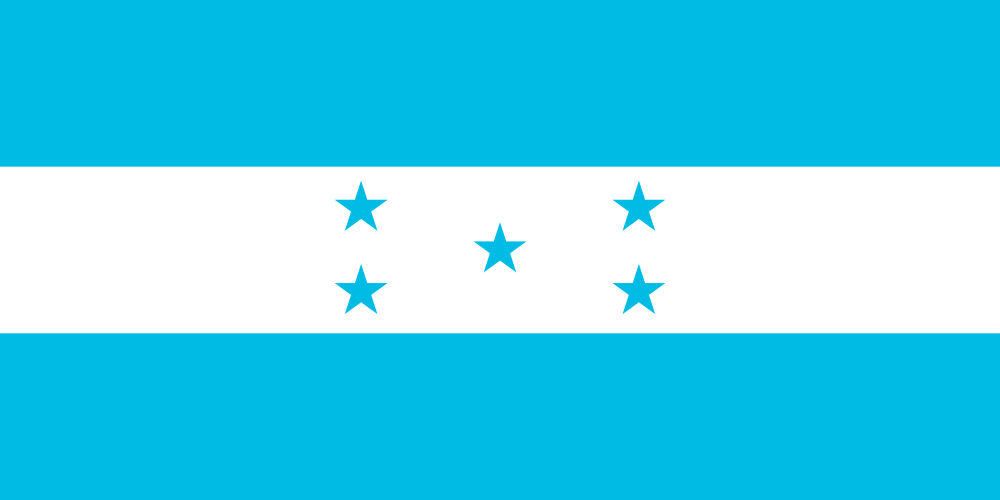
National Flag of Honduras
National Anthem in Honduran Sign Language

Map of Honduras

Ara Macao, Scarlet Macaw, National Bird of Honduras
Photos from Wikipedia.

